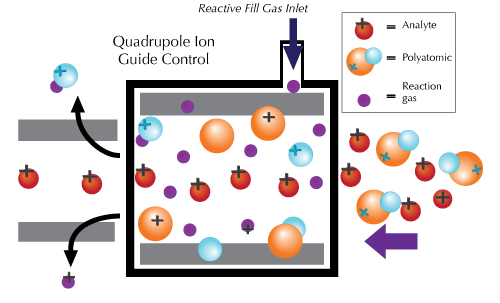Interference Removal by ICP-DRC-MS
(inductively coupled plasma dynamic reaction cell mass spectrometry)
Brooks Applied Labs has an array of different analytical platforms to support the diverse needs of our clients and their projects. One of the analytical platforms used at Brooks Applied Labs is the inductively coupled plasma mass spectrometer with dynamic reaction cell (DRC) technology (ICP-DRC-MS), to accurately determine arsenic, selenium, iron, chromium and various other elements with previously unattainable detection limits. With Dynamic Reaction Cell technology, most polyatomic interferences are reduced to near background levels resulting in dramatic improvements in detection limits and a reduction in biased results for nearly the entire periodic table.
 The DRC is a quadrupole enclosed within a reaction chamber (or cell) that is between the ion lens system and the analyzing quadrupole. A reactive gas such as NH3 is introduced into the cell. The gas reacts with the ion beam through a number of ion-molecule reaction mechanisms, converting the interfering ions into species that will not interfere with the analyte. The analyte of interest, under the same conditions, remains stable and is able to proceed to the detector. This cleansing process is known as “chemical resolution”.
The DRC is a quadrupole enclosed within a reaction chamber (or cell) that is between the ion lens system and the analyzing quadrupole. A reactive gas such as NH3 is introduced into the cell. The gas reacts with the ion beam through a number of ion-molecule reaction mechanisms, converting the interfering ions into species that will not interfere with the analyte. The analyte of interest, under the same conditions, remains stable and is able to proceed to the detector. This cleansing process is known as “chemical resolution”.
Conventional ICP-MS are prone to interferences from the matrix components that form polyatomic species in the plasma. Dynamic reaction cell is designed to reduce interferences and overcome many of these limitations. The end result is the elimination of false-positives and lowest detection limits for the toughest matrices.
The engineering of the DRC chamber, when operated with specific reaction gasses and conditions, also induces ion beam smoothing. The peristaltic pump used for introduction of the sample stream into the ICP-MS produces a pulsation effect due to the rotors associated with all peristaltic pumps (thus, all ICP-MS instruments). The pulsation of the sample stream is ultimately translated to a sinusoidal ion beam after the sample is introduced to the plasma. The waveform of the ion beam contributes to a greater variability in replicate measurements at the instrument. With ion beam smoothing technology, the ICP-DRC-MS can support a much more static ion beam equating to less variability in replicate measurements and can support stable isotope ratio measurements whereas other ICP-MS platforms cannot purport such claims.
More information about how ICP-DRC-MS works read our publication on Advanced Analytical Services for ICP-MS with DRC.
Brooks Applied Labs has some of the lowest detection limits commercially available to our clients. Contact Us to get a customized list of our current MDL/MRL’s for your project.
To learn more about our innovative analytical methods and how they can benefit your projects, contact us today.
